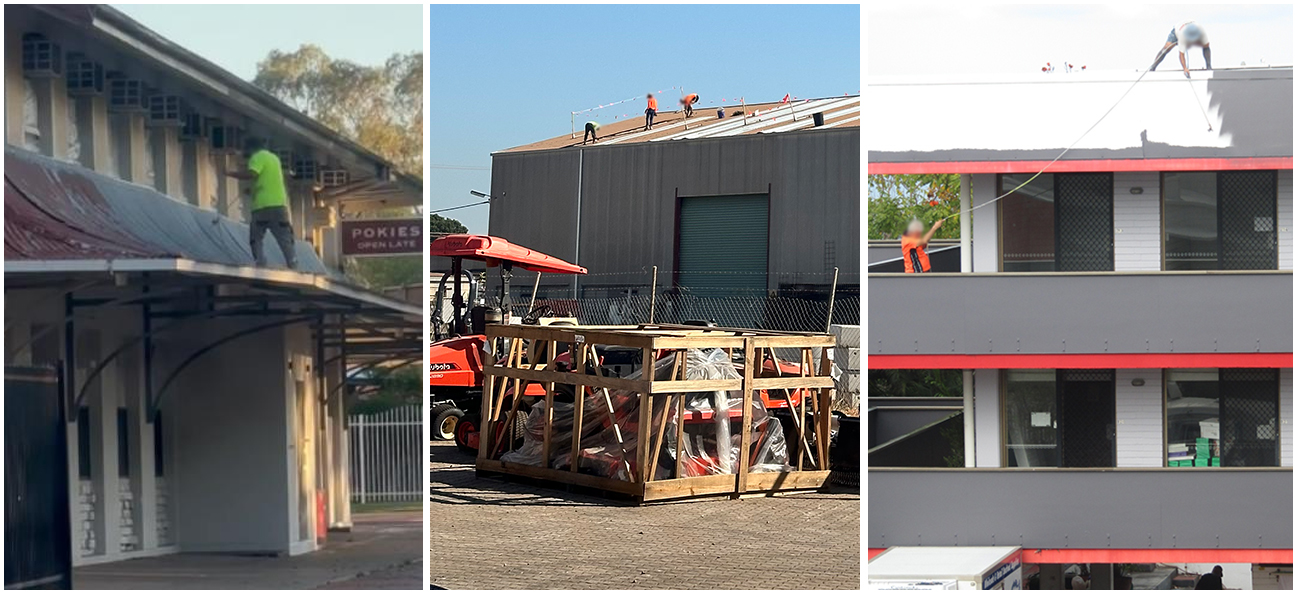Territory workers continue to ignore falls from height risks
Background
NT WorkSafe is reminding all businesses and workers of the risks of working at heights, and the requirements to manage those risks.
The latest national data from Safe Work Australia indicates falls from a height was the second highest contributor to worker fatalities in Australia, with a concerning increase of 71% since 2022, from 17 to 29 fatalities.
Despite these concerning statistics, Territorians continue to ignore the risks as seen in the images below.

In the first incident in mid-September, a worker was observed by WorkSafe Inspectors in Alice Springs standing on a first level awning without fall protection.
Two days later, concerned members of the public alerted WorkSafe Inspectors in Darwin of three workers working on an industrial shed approximately 8.5 metres in height without fall protection.
A week later in the Darwin CBD, NT WorkSafe were alerted again by concerned members of the public who observed a painter standing on the roof of a three storey building leaning over the roof’s edge painting, again without fall protection.
NT WorkSafe is conducting enquiries into a further five instances of working at heights without fall protection that have occurred since September.
Possible enforcement options available to NT WorkSafe include issuing infringement notices ($3640 for a business and $760 for an individual) or prosecution for breaching the Work Health and Safety (National Uniform Legislation) Act 2011.
Disclaimer
The above information is based on preliminary findings from NT WorkSafe’s initial enquiries. Enquiries are ongoing to determine the cause of the incident and the appropriate regulatory response.
Safety Information
Falls are a major cause of death and serious injury in Australian workplaces. Regardless of the task, if there is a risk of a person falling from one level to another, the person conducting the business or undertaking (PCBU) must manage the risks associated with the hazard.
NT WorkSafe strongly urges all workplaces undertaking similar activities to ensure the following measures are in place, and that they are effective:
- Undertake Hazard Identification, Risk Assessment and Control (HIRAC) beginning by identifying hazards related to risks of falls in the workplace using Managing the risk of falls at workplaces Code of Practice.
- Persons in the workplace have appropriate training and instructions necessary to protect them from risks to their health and safety; associated with working at heights.
- Consider available control measures and implement them to eliminate the risk so far as is reasonably practicable, where it is not reasonably practicable to eliminate the risk, minimise the risks so far as is reasonably practicable. The PCBU must manage the risk of falls in a workplace by providing a safe system of work, which may include one or more of the following:
- fall prevention device
- if it is not reasonably practicable to provide a fall prevention device, provide a work positioning system; or
- if it is not reasonably practicable to comply with either a or b ,provide a fall arrest system, so far as is reasonably practicable.
- Discuss the hazards identified and the control measures you have implemented at your next toolbox talk or team meeting.
- Follow the Northern Territory’s Work health and safety consultation, cooperation and coordination Code of Practice, and consult your workers and their health and safety representatives when deciding how to manage the risks in the workplace, including when reviewing and making changes to existing processes.
The Work Health and Safety (National Uniform Legislation) Regulations 2011 classify a number of activities as ‘high risk construction work’ for which a Safe Work Method Statement (SWMS) must be prepared before the work starts.
This includes construction work where there is a risk of a person falling more than two metres or works carried out in or near a tunnel, shaft or trench that has a depth greater than 1.5 metres. For further information on developing a SWMS see Appendix E - High risk construction work safe work method statement template of the Construction Work - Code of Practice.
Further Information
- Code of Practice - Managing the risk of falls in housing construction
- Code of Practice - Managing the risks of falls at workplaces